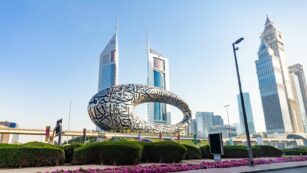As the world evolves, so does the field of architecture, constantly pushing the boundaries of design, sustainability, and technology. Future architecture isn’t just about the aesthetic appeal of new buildings but also about how these structures can improve our lives, conserve energy, and harmonize with our environment. Innovations such as self-healing concrete, 3D printed houses, and smart buildings are no longer just concepts but are becoming a reality, reshaping our urban landscapes.
Future Architecture
Future architecture designs integrate the latest in material innovation and urban development strategies. They focus on enhancing the livability and sustainability of growing urban environments.
Sustainable Building Materials
 Emerging sustainable building materials are set to revolutionize the construction industry. Materials like self-healing concrete, which incorporates bacteria that produce limestone to automatically fill cracks, significantly extend a building’s lifespan. Bamboo, another sustainable choice, offers strength and flexibility, thus proving to be an excellent alternative to traditional hardwoods and steel. Additionally, researchers are developing transparent wood as a more sustainable and aesthetically pleasing alternative to glass, which also provides better insulation. These materials not only contribute to the physical durability of structures but also enhance their environmental friendliness by minimizing their ecological footprint.
Emerging sustainable building materials are set to revolutionize the construction industry. Materials like self-healing concrete, which incorporates bacteria that produce limestone to automatically fill cracks, significantly extend a building’s lifespan. Bamboo, another sustainable choice, offers strength and flexibility, thus proving to be an excellent alternative to traditional hardwoods and steel. Additionally, researchers are developing transparent wood as a more sustainable and aesthetically pleasing alternative to glass, which also provides better insulation. These materials not only contribute to the physical durability of structures but also enhance their environmental friendliness by minimizing their ecological footprint.
Smart Cities and Urban Planning
Smart cities integrate information and communication technologies to enhance the quality and performance of urban services such as energy, transportation, and utilities, thus reducing resource consumption, wastage, and overall costs. The foundation of a smart city is its ability to harness data through sensors and analytics to make informed decisions, optimizing the use of resources. For instance, smart grids manage electricity demand efficiently, reducing energy consumption, while intelligent traffic management systems minimize traffic congestions by adjusting signals based on real-time traffic data. Urban planning in smart cities prioritizes not just technological integration but also accessibility, green spaces, and community-based solutions, fostering a holistic environment that supports sustainability and enhances the quality of life.
Technological Innovations in Architecture
Technological advancements continue to influence the field of architecture, promising dynamic changes and solutions to modern building challenges.
Artificial Intelligence in Design
 Architects harness artificial intelligence (AI) to optimize building designs with greater efficiency and precision. AI algorithms assist in modeling complex data inputs, leading to smarter, more adaptive building designs. This technology supports the creation of structures that are not only aesthetically pleasing but are also highly functional and energy-efficient. For instance, AI-driven tools like generative design software allow architects to explore thousands of design options quickly, selecting the ones that best meet specific criteria such as cost, time, and material constraints. These programs also predict operational inefficiencies and maintenance needs, thereby enhancing the lifecycle of the buildings.
Architects harness artificial intelligence (AI) to optimize building designs with greater efficiency and precision. AI algorithms assist in modeling complex data inputs, leading to smarter, more adaptive building designs. This technology supports the creation of structures that are not only aesthetically pleasing but are also highly functional and energy-efficient. For instance, AI-driven tools like generative design software allow architects to explore thousands of design options quickly, selecting the ones that best meet specific criteria such as cost, time, and material constraints. These programs also predict operational inefficiencies and maintenance needs, thereby enhancing the lifecycle of the buildings.
The Rise of 3D Printing
3D printing technology has emerged as a pivotal innovation in architecture, facilitating the rapid construction of complex building structures directly from digital models. It enables the use of diverse materials, including concrete and polymers, which are layered to create buildings in significantly less time compared to traditional construction methods. Key projects like the 3D printed homes in Eindhoven, Netherlands, exemplify this trend, highlighting the method’s potential to reduce labor costs and production waste. Besides accelerating the construction process, 3D printing promotes sustainability by minimizing excess material use and offering the capability to repurpose materials from demolished buildings, fostering a more sustainable construction cycle.
Challenges and Solutions in Future Architecture
Addressing Urban Density
 Cities around the world are experiencing unprecedented growth. It results in increased urban density, which strains the existing infrastructure. Future architecture must address this by optimizing building space and incorporating multi-use structures. Efficient use of vertical space, such as mixed-use developments, combines residential, commercial, and recreational facilities in one footprint. For example, Tokyo and Singapore adopt intelligent design strategies that effectively manage their dense populations.
Cities around the world are experiencing unprecedented growth. It results in increased urban density, which strains the existing infrastructure. Future architecture must address this by optimizing building space and incorporating multi-use structures. Efficient use of vertical space, such as mixed-use developments, combines residential, commercial, and recreational facilities in one footprint. For example, Tokyo and Singapore adopt intelligent design strategies that effectively manage their dense populations.
Enhancing Durability Against Climate Change
Buildings are vulnerable to the changing climate, which exposes them to more severe weather conditions. Future architecture applies materials like self-healing concrete and innovative designs to increase resilience. These materials recover from cracks autonomously, dramatically improving a building’s lifespan and safety features. Strategies such as elevated designs in flood-prone areas and enhanced thermal performance coatings help buildings withstand various climate adversities.

